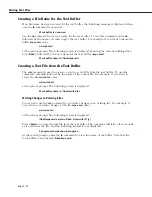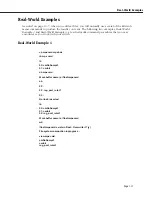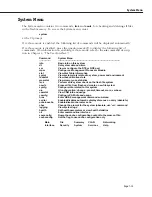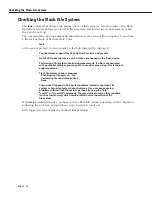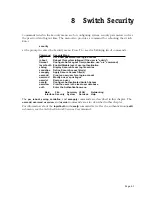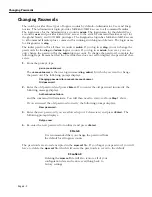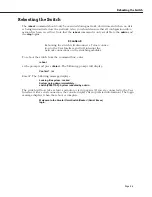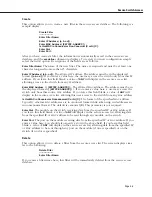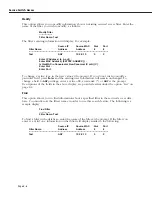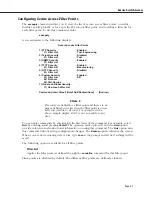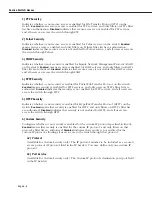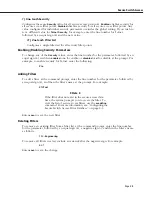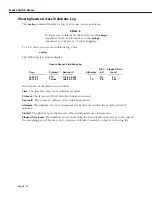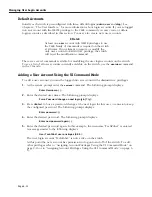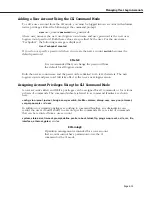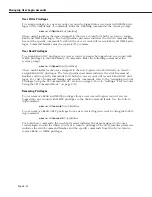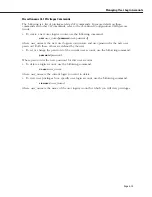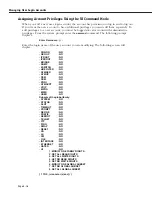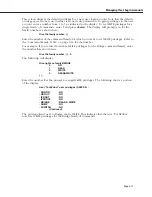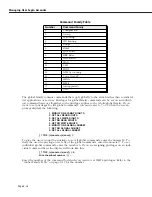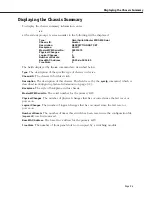
Secure Switch Access
Page 8-8
1) FTP Security
Indicates whether or not secure access is enabled for File Transfer Protocol (
FTP
) on the
switch.
Enabled
means secure access is enabled for
FTP
services, and only filters on
FTP
’s filter
list have authorization.
Disabled
indicates that secure access is not enabled for
FTP
services,
and all users can access the switch through
FTP.
2) Telnet Security
Indicates whether or not secure access is enabled for Telnet service on the switch.
Enabled
means secure access is enabled, and only filters on Telnet’s filter list have authorization.
Disabled
indicates that secure access is not enabled for Telnet service, and all users can access
the switch through Telnet.
3) SNMP Security
Indicates whether or not security is enabled for Simple Network Management Protocol (
SNMP
)
on the switch.
Enabled
means security is enabled for
SNMP
services, and only filters on
SNMP
’s
filter list are authorized.
Disabled
indicates that secure access is not enabled for
SNMP
services,
and all users can access the switch through
SNMP
.
4) TFTP Security
Indicates whether or not security is enabled for Trivial File Transfer Protocol on the switch.
Enabled
means security is enabled for
TFTP
services, and only users on
TFTP
’s filter list are
authorized.
Disabled
indicates that security is not enabled for
TFTP
services, and all users can
access the switch through
TFTP
.
5) HTTP Security
Indicates whether or not security is enabled for HyperText Transfer Protocol (
HTTP
) on the
switch.
Enabled
means that security is enabled for
HTTP
, and only filters on
HTTP
’s filter list
are authorized.
Disabled
indicates that security is not enabled for
HTTP
, and all users can
access the switch through
HTTP
.
6) Custom Security
Configures whether or not security is enabled for the custom IP protocol specified in line 62.
Enabled
means that security is enabled for the custom IP protocol, and only filters on that
protocol’s filter list are authorized.
Disabled
indicates that security is not enabled for the
custom IP protocol, allowing all users access to the switch through that protocol.
62) Protocol
(Available for Custom Security only.) The IP protocol number to be included as a secured
access protocol (
IP
protocol field in the IP header). You may define only one custom IP
protocol.
63) Port Service
(Available for Custom Security only.) The Custom IP protocol’s destination port (port field
in the IP header)
Summary of Contents for Omni Switch/Router
Page 1: ...Part No 060166 10 Rev C March 2005 Omni Switch Router User Manual Release 4 5 www alcatel com ...
Page 4: ...page iv ...
Page 110: ...WAN Modules Page 3 40 ...
Page 156: ...UI Table Filtering Using Search and Filter Commands Page 4 46 ...
Page 164: ...Using ZMODEM Page 5 8 ...
Page 186: ...Displaying and Setting the Swap State Page 6 22 ...
Page 202: ...Creating a New File System Page 7 16 ...
Page 270: ...Displaying Secure Access Entries in the MPM Log Page 10 14 ...
Page 430: ...OmniChannel Page 15 16 ...
Page 496: ...Configuring Source Route to Transparent Bridging Page 17 48 ...
Page 542: ...Dissimilar LAN Switching Capabilities Page 18 46 ...
Page 646: ...Application Example DHCP Policies Page 20 30 ...
Page 660: ...GMAP Page 21 14 ...
Page 710: ...Viewing the Virtual Interface of Multicast VLANs Page 23 16 ...
Page 722: ...Application Example 5 Page 24 12 ...
Page 788: ...Viewing UDP Relay Statistics Page 26 24 ...
Page 872: ...The WAN Port Software Menu Page 28 46 ...
Page 960: ...Deleting a PPP Entity Page 30 22 ...
Page 978: ...Displaying Link Status Page 31 18 ...
Page 988: ...Displaying ISDN Configuration Entry Status Page 32 10 ...
Page 1024: ...Backup Services Commands Page 34 14 ...
Page 1062: ...Diagnostic Test Cable Schematics Page 36 24 ...
Page 1072: ...Configuring a Switch with an MPX Page A 10 ...
Page 1086: ...Page B 14 ...
Page 1100: ...Page I 14 Index ...

